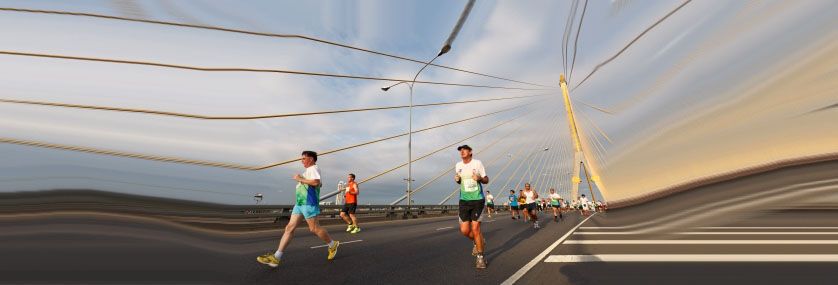Every morning, before the sun rises in Eldoret or Iten, cities in Kenya's Rift Valley and cradle of many of the best long-distance runners in history, large groups of runners gather in silence, a silence that is barely broken while they do gentle stretches. Still half asleep and focused on what they know lies ahead, they are about to begin the first of two training sessions that they will complete, as they do every day.
Without anyone giving a signal, a gentle jog begins, the group advances slowly, compactly, at a pace that any of us can assume. We hear the footsteps, little by little, it seems that there is no hurry; the minutes pass and the pace increases, the group begins to stretch, but there are no sudden changes. The speed increases progressively, faster and faster, faster and faster until finishing the last minutes really strong. Depending on the day and the group will have done between 18 and 22 kms approximately, pure routine for them although not without effort.
We are not in Kenya nor have the level of these athletes, but basically that's the way many of us, popular runners of a wide range of brands, do our long runs, reaching, depending on the weeks to go and the athlete himself, up to 35 kms: start at a much softer pace than expected for the marathon, slow progression, increasingly happy rhythms, running at race pace and finish strong, faster than that pace.
We have all done training like this. Neither better nor worse than doing the long run at a more or less constant pace, although each of us has our own opinion and preferences. Now, what would be the right way to do this run in progression? Or what we want to get to, what should be the difference in pace between the first kms and the last ones to meet the goal?
Before starting the run
As previously mentioned, we should start with the warm-up phase, remember what is ideal: a few minutes of jogging, joint mobility exercises, gentle stretching, running technique and a few progressions. In the particular case of the long run, there is a conditioning factor that pushes many runners to skip it even more: the duration and the large number of kilometers of the run itself.
There is a false belief that the time we invest before starting the run will subtract from the final training, i.e., if we plan to dose our rhythms to do a total of, for example, 26 kms, starting the warm-up with 2 light kms will result in not reaching more than 24 according to the established rhythms. A particular and extreme case of this is the marathon itself, where many runners start the race without having warmed up at all, absolutely nothing.
On the contrary, as it is more than demonstrated and recommended by all trainers and sports doctors, the warm-up will only contribute positively so that our body will be in better conditions to face what is coming, including the total kms.
Concretely, an athlete who is preparing marathon for 3 hours, that is to say, at 4:15 minutes/km approximately, and who vaya to start a 26 kms run in progression can (and should) include in the warm up a short jog at 5:00-5:30 min/km. In the case of looking for the 3h30m mark, those paces we are talking about could range between 5:30 and 5:40 min/km. In both paces and in all the others we are talking about approximately, some of us find it more difficult to warm up and others less, but, in any case, the 3 hour athlete should not warm up at 4:30 nor the 3h30m athlete at 5:10 but much softer. There will be time to run.
If there is no time or desire for this specific warm-up, it should be introduced in the run itself, something that in reality, consciously or unconsciously we do.
You may be interested in: running time and pace calculator
The run itself
And this is where we really get down to business. In this training that Kenyans do, the warm-up is included in the first kilometers, but in our case, if we start the long run very gently, too gently as a warm-up, it would be more convenient not to count those minutes in the net of the run: neither of the total kilometers nor of the average pace that we get. On the day of the marathon we will try to run at a more or less constant pace during the 42 km, a pace that we have to work on in training, but also in this one, trying to complete most of it not far from it.
The progression run should start at a pace between 20 and 40 seconds (maximum) slower than the race pace and gradually increase the speed, trying to keep a good time at marathon pace and finishing the last kilometers a little faster than the target pace, but no more than 10-15 seconds/km.
In this way, from start to finish there should be no more than 30-50 seconds and the resulting average pace slightly lower than the marathon day target. That is the way it would seem logical that you should run a "textbook" long run, with the admissible small margin in the numbers. Anything that deviates from any of those parameters we will have to know how to interpret, that is:
- If we finish much faster than the race pace and also for quite a few kms we should consider that the mark to be sought may be lower, i.e. better. This should be confirmed in the other training sessions, especially in long series and runs at controlled paces.
- If we are forced from the beginning, it is difficult to make progress and we do not even manage to finish a few kilometers at a good pace, we will be in the opposite case, in the case of considering that our goal is perhaps too ambitious. Be careful, we all have a bad day (and more than one), we must discern, make a mental review and review the training already completed to see in perspective everything we have done so far and what we still have to do.
In any case it is a demanding training, with a significant physical and mental wear in which we also work the head. We have to finish tired, but not exhausted, since we are not competing but preparing for it. Sometimes we give it more importance than it has, especially on those occasions when we do not do well, when we do not comply with the plan or with what our training sessions theoretically say.
It is advisable that there is a smooth and steady progression in the pace to finish strong, tired by the accumulated kms, but going to more. This way we will have a good feeling and we will have gained confidence, so that together with the rest of the training sessions of our planning we will arrive in the best conditions to the race.
A marathon begins at the very moment we start with the preparation, the day of the 42195 meters is nothing more than the culmination of all that effort, the great long run.
Read more news about: Running Training


















